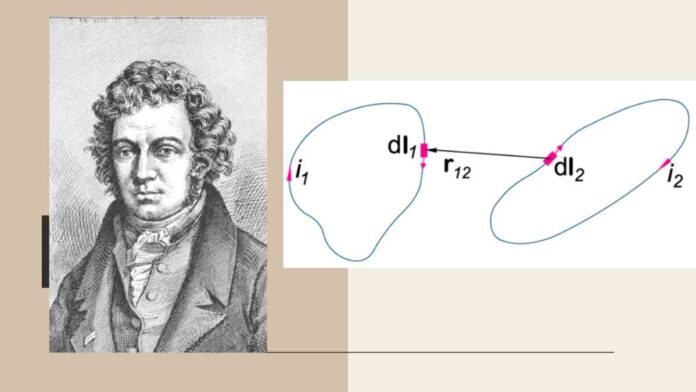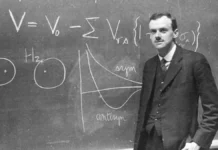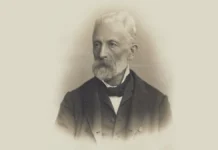Andre-Marie Ampere was a French physicist and mathematician, who is considered one of the founders of the science of classical electromagnetism. He referred to the science of electromagnetism as electrodynamics. Ampere is also the inventor of many other applications, such as solenoid (a term he coined) and the electrical telegraph.
Andre-Marie Ampere was also a member of the French Academy of Sciences, and a professor at the Ecole Polytechnique and the Collège de France. The SI unit of measuring an electric current is named after him. His name is one of 72 names inscribed on the Eiffel Tower.
Contents
Early Life of Andre Marie Ampere
Birth and education
Andre Marie Ampere was born on 20 January 1775 in France to a prosperous businessman. Jean-Jacques Ampere was the father of Andre Ampere. He spent his childhood and adolescence on the family estate in Polymix-au-Mont-d’Or near Lyon. Jean-Jacques Ampere was an admirer of Jean-Jacques Rousseau’s philosophy, whose principles of education became the basis of Andre Ampere’s education.
Russo believed that young boys should avoid formal education, instead get education by nature. On this idea of Russo, Andre Ampere’s father encouraged him to educate himself within his library. During his school, the young Ampere resumed his Latin lessons, which enabled him to master the works of Leonhard Euler and Daniel Bernoulli.
Furthermore, Ampere started using the latest books to start teaching advanced mathematics from the age of 12. In his later life, Ampere has claimed many times that he knew as much about mathematics and science as he knew at the age of eighteen. Along with mathematics and science, he also taught history, travel, poetry, philosophy, and natural science. His mother was a devout woman, so Ampere was initiated into Catholicism along with knowledge science.
Young andre marie ampere
Ampere’s father was called into public service by the new revolutionary government at the time of the French Revolution (1789–1799), which began during his youth when the Jacobin faction fighting for the freedom of equality took control of the revolutionary government in 1792. When seized, Ampere’s father Jean-Jacques Ampere greatly opposed the new political tide but was convicted and sentenced to death on 24 November 1793 as part of the Jacobin purse of the period. The time in Ampere’s life was a time of great sorrow that he could never forget.
Marriage
In 1796, Ampere met Julie Carron, the daughter of a blacksmith living near Lyon. He married Julie Carron in 1799.
Andre Marie Ampere’s career
Ampere received his first regular job as a mathematics teacher in 1799, which gave him the financial security to marry his first child Jean-Jacques (named after his father) the following year. (Jean-Jacques Ampere eventually achieved his fame as a scholar of languages).
Ampere’s maturity coincides with the transition to Napoleonic rule in France, thus young Jean-Jacques and his father found new opportunities for success within the technical characteristics favored by the new French First Consul.
In 1802 Ampere was appointed Professor of Physics and Chemistry at the Centcole Centrale of Bourg-en-Bresse. He used his time at Bourg to research mathematics, writing a treatise on mathematical probability, producing the “Games of the Mathematical Theory of Games”, which he sent to the Paris Academy of Sciences in 1803.
After his wife’s death in July 1803, Ampere moved to Paris, where he started a tuition post in 1804 at the Ecole Polytechnique. Despite the lack of formal qualifications, Ampere was appointed as a Professor of Mathematics at the school in 1809.
While holding positions at this school until 1828, in 1819 and in 1820 Ampere offered courses in philosophy and astronomy at the University of Paris, respectively, and in 1824 he was selected for a prestigious position in experimental physics at the College de France. In 1814 Ampere (Ampere) was invited to join the class of mathematicians at the new Institute Imperial, which later reformed the state’s Academy of Sciences.
Ampere was engaged in a diverse array of scientific research during the years leading up to his election to the academy – writing papers and engaging in subjects ranging from mathematics and philosophy to chemistry and astronomy, which was customary among the leading scientific intellectuals of the day.
Ampere claimed that “at the age of eighteen, he found three endpoints in his life, his first communication, the reading of Antony Leonard Thomas’s” Alsogie of Descartes “and the Bastille taking. Two verses on the day of his wife’s death Write. By hymn and prayer, ‘Lord, God of mercy, unite me in heaven with those whom you have allowed me to love on earth.’ During Duress’s time, he took refuge in the reading of the Bible and church fathers. “
For some time he took the young student of his family, Frederick (1813–1853), one of the founders of the Conference of Charities, later known as the Society of St. Vincent de Paul. Through Ampere, Ozanam had contacts with leaders of the Neo-Catholic movement, such as François-René de Chateaubriand, Jean-Baptiste Henri Lacordaire, and Charles Forbes René de Montaltat. Ozanam was defeated in 1998 by Pope John Paul II.
His contribution to electromagnetism
In September 1820, Ampere’s friend and François Arago demonstrated to members of the French Academy of Sciences the surprising discovery of Danish physicist Hans Christian, in which a magnetic needle is deflected by an adjacent electric current.
When Ampere came to know of this, he began to develop a mathematical and physical theory to understand the relationship between electricity and magnetism. Furthering Hans Christian’s experimental work, Ampere showed that two parallel wires carrying an electric current attract each other, or repel each other, depending on whether the currents flow in the same or opposite directions respectively. His experiment laid the foundation for electrodynamics.
He also applied mathematics to normalize physical laws from these experimental results. The most important of these was the principle known as Ampere’s law, which states that the interaction of two lengths of current-carrying wire is proportional to their length and the intensity of their currents. (which states that the mutual action of two lengths of current-carrying wire is proportional to their lengths and to the intensities of their currents)
Ampere also applied the same principle to magnetism, showing the harmony between his law and the magnetic action of French physicist Charles Augustin de Coulomb.
Ampere also provided a physical understanding of the electromagnetic relationship, which testifies to the existence of an “electrodynamic molecule” (the precursor to the idea of electrons), which is the constituent element of both electricity and electromagnetic relationship.
Using this physical explanation of electromagnetic motion, Ampere developed a physical account of electromagnetic phenomena that were both empirically demonstrative and mathematically predictable.
In 1827 Ampere published his Magnum Opus (Memoirs on the Mathematical Theory of Electrodynamic Phenomena, devoted exclusively by experience) to the work that coined the name of his new science, electrodynamics.
His other discoveries
- Ampere’s circuital law
- Ampere’s force law
- Avogadro-Ampere hypothesis
Awards and honors
Thus, in 1827 Andre Marie Ampere was elected a foreign member of the Royal Society and in 1828 a foreign member of the Royal Swedish Academy of Science.
In 1881, in recognition of Ampere’s contribution to the construction of modern electrical science at an international conference of the International Exhibition of Electricity, Ampere was also established as a standard unit of electrical measurement, with coulomb, volt, ohm, and watt.
Ampere’s contemporary is named after Charles-Augustin de Coulomb of France, Alessandro Volta of Italy, Georg Ohm of Germany, and James Watt of Scotland. Thus Andre Marie Ampere’s name became one of the 72 names inscribed on the Eiffel Tower.
And many items are also named after Ampere, many roads and squares, schools, Lyon metro station, and an electric ferry in Norway.
Death
10 June 1836 at the age of 61
In Marseille, Kingdom of France.
Sources
- Electrical unit history.
- Ampère and the history of electricity.
- André-Marie Ampère: The Founder of Electromagnetism.
FACT CHECK: We strive for accuracy and fairness. But if you see something that doesn’t look right, please Contact us.
DISCLOSURE: This Article may contain affiliate links and Sponsored ads, to know more please read our Privacy Policy.
Stay Updated: Follow our WhatsApp Channel and Telegram Channel.












